
Protecting the marine biodiversity capital: Implications of the Apo Island Jetty Port Project on the Apo Island Protected Landscape and Seascape
 Aileen P. Maypa, Ph.D.
Aileen P. Maypa, Ph.D.
Silliman University-Institute of Environmental and Marine Sciences
The Apo Island Jetty Port is a project championed by the incumbent Municipal Mayor, Hon. Galic Truita; supported by the Apo Island Barangay Captain, Hon. Mario Pascobello; and financed through a loan from the Landbank of the Philippines.
According to Resolution No. 22-194 of the Sangguniang Bayan of Dauin Municipality, the Construction of the Jetty Ports in Brgy. Maayong Tubig and Apo Island amounted to Php 207 million.
With this project, Mayor Truita envisions increased tourism in Apo Island along with convenience and comfort, “nga dili na mabasa ang mo adto sa Apo Island,” he stated in Binisaya repeatedly in many occasions.
Though we generally enjoy comfort and convenience during travel (at a price), let us not forget that people pay to visit Apo Island for its marine biodiversity, which includes the sea turtles, the beautiful corals and associated fish, nudibranchs, and other marine organisms. Further, this marine biodiversity also provides resources for our food. Thus, our business capital and food are reliant on the health of our marine biodiversity and its environment.
We, therefore, need to take care of them. Marine organisms are living things, and they have optimum conditions and thresholds in order to thrive.
Apo Island is a Protected Landscape and Seascape established by a Presidential Proclamation 438 in 1994 under the National Integrated Protected Areas System Act (RA 7856 as amended by RA 11038). It is recognized by our nation as one of those unique areas with high diversity and with biologically important habitats that support endangered, threatened, and vulnerable species. Given the above information, it is just right that any development in Apo Island Protected Landscape and Seascape (AIPLS), like the Apo Island Jetty Port must undergo the prescribed governmental processes and be vetted appropriately by the concerned government agencies.
The Apo Island Jetty Port Feasibility Study (FS) was formally presented to the DENR Apo Island Protected Landscape and Seascape (AIPLS) Protected Areas Management Board (PAMB) on November 21, 2022 by Mr. Japril Cataluña.
This FS proposed an Apo Island Jetty Port to be located 75 m from the northern boundary of Apo Island Marine Sanctuary, a strict protection zone within AIPLS. As such, PAMB member then, Dr. Aileen P. Maypa, who at this time, represented the NGO, Coastal Conservation and Education Foundation; and Dr. Janet Estacion, who represented Silliman University (SU) – Institute of Environmental and Marine Sciences (IEMS), submitted a review of the FS and position statement to the PAMB.
In this position statement, the potential negative impacts to the marine life and surrounding environment were detailed by the marine scientist authors. The Regional Executive Director of DENR 7, Pacquito Melichor, Jr., then issued the Regional Special Order 2023-106 to create a technical working group (TWG) to validate the issues, concerns, and impacts raised by Dr. Maypa and Dr. Estacion on the construction of an Apo Island Jetty Port. The TWG then validated the potential impacts mentioned in the subject position statement, and TSD Chief Engr. Normandy Lebelo motioned for the Apo Island Jetty Port to be relocated in Baybay, on the western side of the Island. This motion was seconded with the specification that the design be revised, and the feasibility study be simplified and presented again to the AIPLS PAMB. This is according to a Memo dated May 8, 2023 from the PENR Officer/Protected Areas Superintendent (PASu) of AIPLS, Engr. Vernov Grefalde, for the Regional Executive Director of Region 7 (RED7), Paquito Melicor, Jr., who is also the Chairperson of AIPLS PAMB.
On August 24, 2023, a majority of the AIPLS PAMB members voted for Resolution No. 9, Series of 2023,
“A Resolution approving the construction of the proposed Jetty Port Project of LGU, Dauin, Negros Oriental in the western part of AIPLS, and endorse to the Environmental Management Bureau (EMB) Regional Office (RO7) pursuant to Department Administrative Order (DAO) No. 5 Series of 2019, Rule No. 12.1 and 12.2, respectively.” This is according to a Memorandum from the DENR PENRO for the RED7, dated October 11, 2024.
In a letter, SU, through its president Dr. Betty Cernol McCann, requested an investigation of the conduct of the Apo Island Jetty Port construction to the Honorable DENR Secretary, Antonio Yulo Loyzaga on October 2, 2024. She presented the potential threats of the Apo Island Jetty Port on the: (1) marine biodiversity, (2) cultural and religious heritage, and (3) livelihood and human safety. Further, some Apo Island residents complained that no proper public consultation was made to the community with regard to the construction of the Jetty Port and the demolition of the Apo Island Chapel.
The first investigation was carried out on November 8, 2024 during an AIPLS PAMB Special meeting which was also attended by the representatives of SU per invitation of the DENR PENR Office of Negros Oriental. Among the SU Team’s major concerns were:
- the issuance of EMB7 of an Environmental Compliance Certificate (ECC) without an Environmental Impact Study (EIS) requirement, as vetted and approved by the concerned Office, when Apo Island is categorized as an “Environmentally Critical Area” or ECA based on the Revised Guidelines for Coverage and Screening and Standard Requirements under the Philippine EIS System (EMB Memorandum Circular 005, July 2014) and
- the presentation of a revised Jetty Port design by Mayor Truita to the AIPLS-PAMB on September 6, 2024. He was granted clearance for this revision through Resolution No. 11, Series of 2024. The ECC was granted in November 2019.
It was decided in the same meeting that a representative from EMB be invited in the next meeting. Further, the RED7 ordered the PENR Officer/PASu to issue a suspension order on the Jetty Port construction until a new ECC is issued in the same meeting.
The second AIPLS PAMB meeting with the EMB representative from the Negros Oriental Provincial Monitoring, Mr. Stephen Lee, was conducted on February 14, 2025. In this meeting, Mr. Lee confirmed the decision of the EMB 7 that EIS is not a requirement of the Apo Island Jetty Port since it is only 30 m2 in area (terminal and walkway). However, in the process of an Environmental Impact Assessment (EIA), the following must be considered: (1) the number of people using the Jetty Port at a time, (2) the number of boat loads in a day and their ecological footprint, (3) the area used by how many boats docking on the Jetty Port, (4) the potential oil spill, (5) the noise and its impact to marine animals and others. This calls for an EIS.
To date, “the Apo Island Jetty Port is 80% done,” according to the owner of the Philsouth Properties and Development Corporation, Mr. Loiusito Tijing, who presented two designs of the Apo Island Jetty walkway during the November 14, 2025 AIPLS PAMB meeting.
The Jetty Terminal stands on the site of the demolished Apo Island Chapel which is almost complete, yet the appropriate bodies and offices are still vetting on the design of the Jetty Port walkway. The construction of this Jetty is currently suspended due to the complaints raised when the PhilSouth staff jack hammered the intertidal zone of Apo Island while excavating for the walkway pillars, according to RED7 during the November 14th meeting. However, the Apo Island Jetty Port proponents, through the contractor, PhilSouth, are currently in the process of applying for a new ECC for the revised design without the pillars of the walkway, according to Mr. Louisito Tijing.
We call on the proponents of the Apo Island Jetty Port and the concerned bodies and government agencies to reevaluate and exercise the prescribed vetting processes and appropriate measures for the protection of Apo Island marine biodiversity and a sustainable nature-based ecotourism for Negros Oriental. May DENR be reminded that its mandate is on Environmental Protection and not Development.
For Sillimanians at home and around the world, may the legacy of the late National Scientist and Father of Marine Protected Areas, Professor and Mentor, Dr. Angel C. Alcala, live on.



